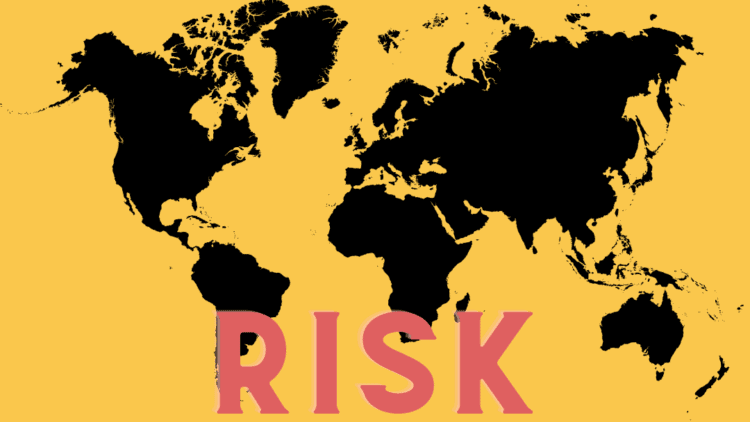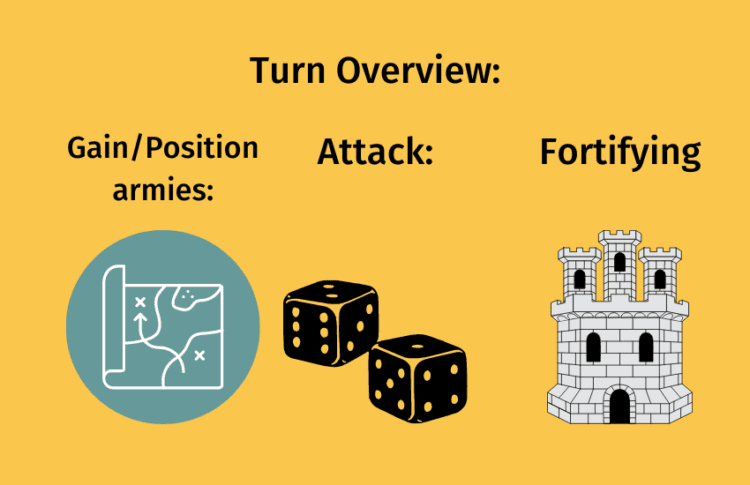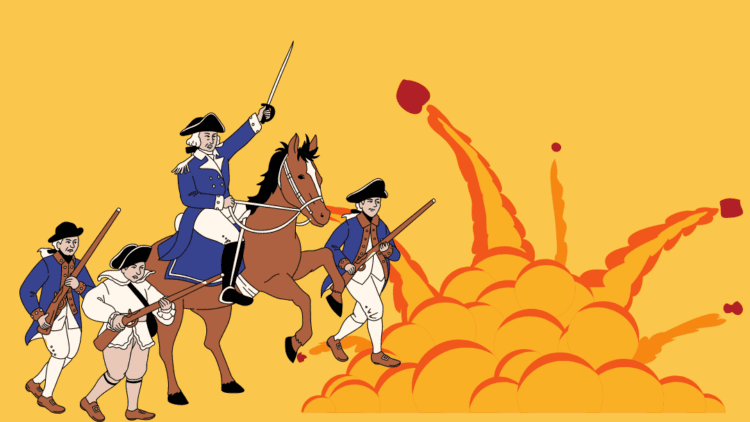
OBJECTIVE: The objective of the game is to occupy every territory on the board and eliminate the other players. The game of world domination!
NUMBER OF PLAYERS: 2 to 6 players
MATERIALS: 1 Tri-fold Game Board, 5 Dice: 2 white and 3 red, Deck of 56 RISK cards, 6 Sets of armies, each a different color.
TYPE OF GAME: Board game
AUDIENCE: All ages
OVERVIEW OF RISK
This post contains some partner links for various products.
- Brand New in box. The product ships with all relevant accessories
- Includes gameboard, armies with 4 Infantry, 12 Cavalry, and 8 Artillery each,...
- PLAY USING ALEXA SKILL: Players have the option of playing this Risk game using...
Let’s face it: all of us, at one time or another, have thought about what it would be like to take over the world. Luckily, there’s a game called Risk that lets you do just that without consequences.
Risk is a classic board game of strategic conquest where players fight for world domination through cunning tactics and calculated maneuvers. As a global leader, you deploy armies, form alliances, and engage in intense battles to expand your territories and seize control of continents. Let’s go over the rules and strategies you can use to take over the world during your next game night!
SET UP FOR RISK

Risk is super fun to play, and you can play with up to six players. It’s quite an easy game to play once you get the hang of it. The setup requires a bit of planning, but once it’s done, then all that’s left is to play and battle your way to the top!
WHAT’S IN THE BOX?
The Risk game comes with a few things in the box.
- 1 game board
- 5 dice (2 white, 3 red)
- 56 RISK cards (42 territory cards, 2 wild cards, 12 secret mission cards)
- 6 sets of armies (8 Artillery, 12 Cavalry, 40 Infantry)
Game Board: The Risk game board is simply a map of 6 continents divided into 42 territories total. Each continent is depicted with a different color, and each contains 4 to 12 territories within its borders.
Armies: There are six complete sets of armies, each containing 3 types:
- Infantry = 1 army
- Cavalry = 5 armies (infantries)
- Artillery = 10 Infantries or 2 Cavalries
The game starts with infantry pieces. However, later in the game, you may trade these pieces for Cavalry or Artillery (or Cavalry for Artillery) according to their respective values above. We will cover this more in the gameplay section.
Cards: There are 42 Cards, each marked with a territory and a picture of Infantry, Cavalry, or Artillery. There are two “wild” cards marked with all three pictures but no territory, and 12 Secret Mission cards used only in Secret Mission Risk. Remove Secret Mission cards if you are not playing that variation.
Dice: There are three red dice and 2 white dice. You will use these later in the game during battles. Since there are two sides to a battle, there are two sets of dice.
ARMY DISTRIBUTION
Now you know what’s in the box it’s time to distribute the pieces. Start by selecting a color. Depending on the number of players in the game, distribute the number of armies accordingly and place them in front of you.
- 3 players = 35 armies each
- 4 players = 30 armies each
- 5 players = 25 armies each
- 6 players = 20 armies each
In a 2-player game, you distribute the armies differently. Classically, players get 50 armies each. However, newer versions of the game give you only 40 armies each and establish a neutral territory with another 40 armies. These are defensive armies for both players only and are never used for offense. When one player attacks the neutral country, the other rolls the dice for that country.
ARMY PLACEMENT
Now, each player rolls one die to determine the first player. Whoever rolls the highest number begins by taking one infantry piece and placing it on a territory, thereby occupying it. The play proceeds to the left.
You keep going, taking turns placing one army on unoccupied territories. Continue until all territories have been claimed.
Once all the territories have been claimed, you can place another army piece on any territory you occupy on your next turn. Continue this until everyone runs out of armies. There is no limit on the number of armies you can place in any single territory.
Shuffle Risk cards and place them face down next to the board. This is the draw pile.
The player who placed the first army also takes the first turn.
HOW TO PLAY

I know that was quite a bit of setup, but it’s all smooth sailing from here. Well, until you go to battle, that is.
Turns in Risk consist of trying to capture enemy territory and defeating your opponent’s armies. Successfully winning battles depends on careful planning and bold moves. To win, you must attack when the time is right while fortifying your defenses.
A turn-in Risk has three steps.
- Gaining and positioning new armies
- Attacking, if you so choose, by rolling the dice
- Fortification of your position
1. GAINING AND POSITIONING NEW ARMIES
At the start of each turn, you will get more armies based on the number of territories you control. Calculate how many new armies to add to your territories by considering:
- How many territories you occupy.
- The value of your controlled continents.
- The value of the matched sets of Risk cards traded in.
- The territory pictured on the card.
TERRITORIES
At the start of each turn, including your first, count the number of territories you occupy and divide by three (ignoring any remainder). The answer is the total number of armies you are to receive. For example, if you occupy 14 territories, you get four armies. (14÷3 = 4.6, round to 4 armies)
You will always get at least three armies, even if you currently occupy less than nine territories.
CONTINENTS
At the start of each turn, you will also receive new armies for each continent you control. In order to control a continent, you must occupy all the territories within it. There is a chart in next to each continent on the game board that defines the number of armies you receive per continent.
- North America – 5 armies
- South America – 2 armies
- Europe – 5 armies
- Africa – 3 armies
- Asia – 7 armies
- Australia – 2 armies
TRADING IN CARDS FOR ARMIES
During the game, you get a chance to draw Risk cards from the draw pile. The ultiamte goal of these cards is to collect sets of 3. A full set is three cards of:
- Same design (3 Infantry, 3 Cavalry, or 3 Artillery)
- one of each of the three designs (1 Infantry, 1 Cavalry, 1 Artillery)
- Any 2 cards plus a wild card.
You can trade the sets in at the beginning of your turn, or you may wait. But, if you have five or six cards, you must trade in at least one set. You should never exceed six cards.
The number of armies you get for your trade in depends on how many sets have been traded in before you. Keep matches face down under the board for quick reference.
- First Set – 4 armies
- Second Set – 6 armies
- Third Set – 8 armies
- Fourth Set – 10 armies
- Fifth Set – 12 armies
- Sixth Set – 15 armies
Following the sixth set, each additional match traded in is worth an extra 5 armies. For example, the eighth set traded in gives you 25 armies.
If any of the territories you occupy are on one of the three cards, you will receive an extra 2 armies. Then you must place both armies in their respective territory.
2. ATTACKING

After positioning your armies, you can choose to attack. The objective of attacking is to capture a territory by defeating all its occupying armies.
You use the dice to fight battles. Although, if you do not wish to attack, pass the dice to the player on your left. You still get to move on to step three, fortifying your position.
RULES OF ATTACKS
- You may only attack territories that touch your own or are connected to it by a dashed line.
- You must have at least two armies in the territory from which you are attacking.
- You can only send up to three armies to attack a territory.
- You must leave at least 1 army in your territory.
- You can continue to attack a territory until you eliminate all its armies, or you can shift your attack to other adjacent territories, attacking as many territories as often as you would like.
- You may only attack one territory at a time and resolve that battle before continuing.
HOW TO ATTACK
Begin by announcing where you plan to attack and what territory you are attacking from. Then, roll the dice against your opponent.
- Before you roll, both you and your opponent must announce the number of dice you plan to roll, and both you and your opponent must roll at the same time.
- Attacker rolls 1, 2, or 3 red dice depending on how many armies they send to attack.
- Defender rolls 1 or 2 white dice. In order to roll 2 dice, the defender must have two or more armies in their territory.
DECIDING A BATTLE
Compare the highest die rolled. If the attacker’s is higher, the defender loses one army. Conversely, if the defender’s is higher, the attacker loses one army. In the event of a tie, the defender always wins.
If both rolled more than one die, compare the next highest pair and apply the same rules.
CAPTURING TERRITORIES
After defeating the last enemy army, you come into ownership of that territory and must immediately occupy it. Occupy the new territory by adding as many armies as you want from your attacking territory. You must leave at least one army in the territory you attacked from. During gameplay, every territory must have at least one army.
You may end an attack at any time. However, if you have succeeded in capturing at least one territory, draw a Risk card from the draw pile. Also, no matter how many territories are successfully captured, you can only draw one card per turn.
ELIMINATING THE OPPONENT
If you eliminate an opponent during your turn by defeating the last of their armies, you win any Risk cards they have collected.
- You must trade in your cards if you have more than six but no fewer than two.
- If drawing a Risk card from conquering a territory and after winning an opponent’s cards puts you greater than 6, you must trade in cards on your next turn.
3. FORTIFYING YOUR POSITION
Every turn ends with fortification. Some players consider this to be a “free move.” To fortify, move as many armies as you want from one of your territories to one of your adjacent territories. Remember: when you move armies, you must leave at least one behind.
END OF GAME
To win the game, you must eliminate all other players and occupy all 42 territories.
RISK STRATEGY

Risk is a very strategy-based game, from the placement of armies to choosing your battles wisely. Let’s go over some of my favorite strategies to help secure you a win.
BABY STEPS
One of the best strategies you’ll hear for Risk is to take baby steps. Let me elaborate. Risk is a very long and complicated game; if you go in wildly trying to attack on every turn and treating the game like a race, you’ll most certainly hurt your chances of winning.
Risk is similar to chess in the sense that in order to win, you must think 2 or 3 moves ahead. The best strategy is to make small, calculated moves. Think about each decision and the consequences it can lead to. These small steps will eventually put you far ahead of everyone else and help your chances.
ALLIANCES
Alliances can definitely help you out during a game. There is no rule against forming alliances with other players. This is a great idea, but it’s important to remember that at the end of the day, your ally now is still your opponent, and your alliance will come to an end. So, while it can be good to have alliances, it’s good not to rely on them.
UNDERSTAND THE MAP
Understanding the map is something that will help you no matter what. Each player has their own ideas of what the best-starting territories are and which places have the most advantages. It’s important to know that while each place has its advantages, it will also have its disadvantages. So get to know the map and how you can expand your reach on the map in the easiest way.
PRACTICE
This is a tip I always give, no matter the game. The more you play, the better you get. Then, you start to understand the map, and you start to develop your own strategies for how to conquer the world. Not to mention, practicing is a great excuse to play a very fun game.
WHERE TO BUY RISK
As one of the most popular board games in the world, Risk is a must-have for any collection of board games – no matter how small. Grab Risk (or one of its many variants) today so you can host the most epic game night to date!
- Risk
- Risk – Game of Thrones Edition
- Risk – The Lord of the Rings Edition
- Risk – Rick and Morty Edition
- Risk – Warhammer 40,000 Edition
- Risk Legacy
- Risk Junior
If you’re looking for the rules for some of the other versions check out some of my favorite Risk variations.
FREQUENTLY ASKED QUESTIONS
How Long Does It Take to Play Risk?
Risk is quite a strategic game, a single game can last anywhere from 1 – 6 hours, with the average being about 4 hours.
Can You Form Alliances in Risk?
Yes, you can form alliances in Risk, there is no rule against this. However, you must remember that the alliance will end.
Can You Play Risk with 2 Players?
You can play Risk with two players, but the setup of the game is different. However, it is recommended to play with three or more players for an optimal game.
Is Risk a Difficult Game?
Risk is not a difficult game. It is really easy to learn how to play, but mastering strategies will take much longer.
- 20+ Epic Outdoor Drinking Games - June 28, 2024
- 30 Gifts for Board Game Lovers - June 27, 2024
- 33 Games for Church Youth Group - June 21, 2024
